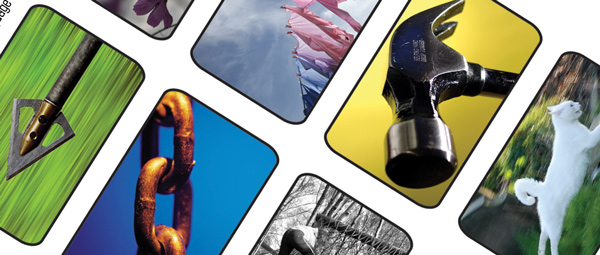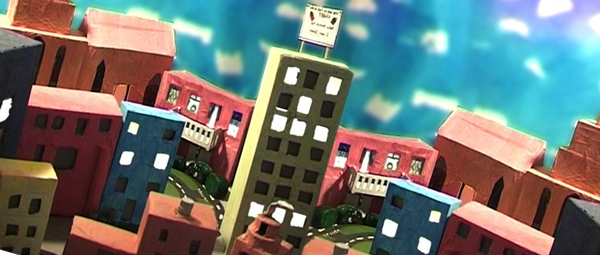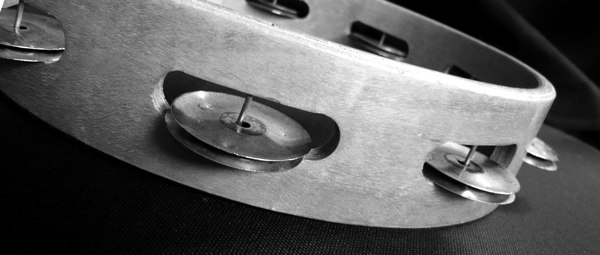Sound for effect
This activity is divided into three parts: a language & writing exercise; a listening exercise and a practical creative exercise - where you will create your own very basic soundtrack.
You will need:
- The Still Image Printout PDF for this section.
- Access to this site or downloaded versions of the picture and sound clips from this page. (you will find these at the end of this extra long page)
- Screen and speakers to play the clips to the class.
- Some means to make music and sound effects – if you have Garageband or a similar package you could use that; if you have access to the music room that’s fantastic; but even within the classroom pencil cases can become shakers, tubs become drums, books make flapping sounds… and human voices can do all sorts of things!
- Ideally (for the last exercise) each group would have access to a separate computer.
- Recording equipment (for the last exercise) if you have it.
Exercise 1 - language & writing
Print off the still images provided here
- Divide the images between the class.
Just the image
Ask students each to describe in writing :
- The kind of sound effect that might accompany their image. They might start with an instinctive, phonetic sound. Ask them to translate it into words. Encourage them to be as creative as possible with their use of language, e.g.'The scrape of metal against metal'. (It helps to think about how you might create the noise if you had to record it, and the effect you want to have on the audience)
- The kind of music that might accompany it: 'Bubbly, light music like the sound of laughter'.
- How would it be filmed – would the camera move and if so how? Would this shot last a long time, or would it change quickly to a different one? 'It changes quickly to the beat of fast music.'
Make the image part of a film
Now, using their same image, and the ideas they have developed about it, ask the class to make this the first shot from a scene in a film.
Ask them to develop a short narrative, taking this image as a starting point, and to describe how the image, sound effects and music would help to tell this part of the story.
Exercise 2 - adding a soundtrack
In this exercise the class are to choose the most appropriate soundtrack for a piece of film.
We have provided sample clips for you to use, below.
Music & picture separately
Firstly, play the mute film clip to the class.
Then play the four pieces of music without any images and ask the class whether they think each one would fit with the film clip. And if not the whole of it, any part of it?
Ask them to explain their reasons.
Music and picture together
Now play the film clip with each of the pieces of music.
- Does the style of the music suit the style of the film? Why/why not?
- Is the pace right or wrong?
- Does the music create the right emotional feel?
- How do different pieces of music alter your impression of the images, the story and the characters?
We have provided a short film clip from an education animation and four different soundtracks so you can do this exercise immediately. But remember you could also create samples of your own - you might choose a hollywood classic or a film created in your school, and work with any number of soundtracks.
Exercise 3 - create your own soundtrack
This is a practical creative exercise, which is a lot of fun.
You'll need a short film which you can play mute.
To start
Divide the class into groups, and within each have a sound designer/director. Divide your short film into the following parts and split them between different groups, so that they can each concentrate on creating melodies, sound effects and stings for different bits of the film:
- The opening titles - setting the mood for the whole film
- Different characters - characters often have their own refrains that suggest something about them, for example if they are clumsy or scary
- Locations - a stormy sea would have very different music from the inside of a prison cell for example
- Moments of tension and drama, moments of calm, relief and humour
- Climax
- Closing shots and credits
Secondly
Each group should now work on their section of the film, making spot effects, atmos and music for each part.
Finally
Play the soundtrack with the film. If you have recording equipment and video software you can add your soundtrack to the film and play it all through to the class at the end of this exercise. But it is simpler and almost as effective to do it the old way, and gather each group together like an orchestra, with the director becoming a conductor, set the film playing, and let the performance commence! If you can record each soundtrack, then great - it will enable you to review and analyse the effect it has carefully. But if not, all those not performing can help to 'judge' the appropriateness and say what effect is has on them and their perception of the film.
Voices can be used to make sounds - but no dialogue!
All the assets for exercise 2
The Still Image PDF
The film clip with no sound
Four different soundtracks - without picture
Sound Clip A
Sound Clip B
Sound Clip C
Sound Clip D


